What is Vegetative Reproduction in Plants
Vegetative reproduction
In some plants, vegetative parts such as root, stem, and leaf can be used to produce new plants. This type of reproduction, known as vegetative reproduction, can be done by natural as well as artificial methods.
Natural Methods
Most plants reproduce naturally without the involvement of human beings. They do so with the help of stems, roots, and leaves.
1. Roots
Tuberous roots of Dahlia, sweet potato, and Asparagus can be set aside for multiplication in the next season. These roots have food stored in them.

Read More:
- Reproduction in Humans
- Different Types of Asexual Reproduction
- Sexual Reproduction in Flowering Plants
- Viviparous Reproduction
2. Stems
Stems are the most common parts involved in vegetative propagation. Vegetative
propagation through stems is of the following types:
- Plants such as Oxalis and grass have horizontal stems growing parallel to the ground, almost touching it. New roots sprout from the nodes (slightly swollen areas occurring at regular intervals on a stem or branch). New shoots also grow upwards forming new plants at frequent intervals.
- In plants such as mint and Chrysanthemum, horizontal stems arise from the base of the erect shoot, grow horizontally in the soil, and then come out to form new aerial shoots. These shoots become independent plants when stems break away from the parent plants.
- Some plants have arched stems which cross over small obstacles and develop small plantlets at their nodes, e.g., Vallisneria, wild strawberry.

Oxalis 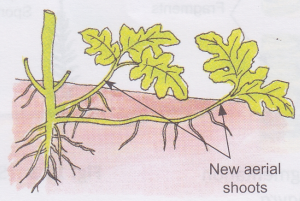
Chrysanthemum
Some plants have stems which grow underground. They are mostly swollen because they have food stored in them. This food is used by the new plants to grow. The different types of underground stems are: rhizomes, bulbs, tubers, and corms.
- Rhizomes They have buds from which outgrowths are produced which give rise to new plants. This is seen in ginger, turmeric, and banana.
- Bulbs They are very short underground stems encased in thickened fleshy bulb scales (which are modified leaves). The scales serve as sites of food storage. This is seen in onions. In the spring, when a new plant shoots up from the centre of the scale cluster, it gets its food from scales.
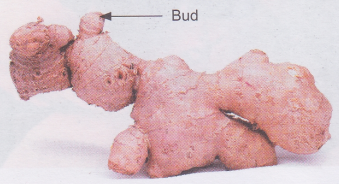
Rhizome of ginger 
Scale leaves of onion - Tubers They have buds in the eyes, which give rise to new plants, e.g., potato.
- Corms They are lots of rhizomes joined together which develop into new plants, e.g., Gladiolus and Colocasia.

Tuber of potato 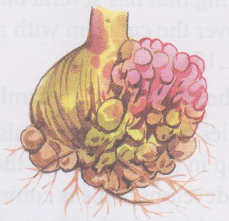
Corm of Gladiolus
3. Leaves
Leaves of a number of plants, such as Bryophyllum, develop small buds, called adventitious buds, on their margin. These buds grow into new plants when the leaf falls from the parent plant.

Artificial Methods
Plants can also be produced vegetatively by artificial means. These methods include cutting, grafting, and layering:
1. Cutting
It involves cutting off part of a stem, leaf, or root and placing it in moist soil. After some time, these stems develop roots at the base and grow into a new plant. This method is generally used for multiplying sugarcane, rose, Bougainvillea, and hibiscus.
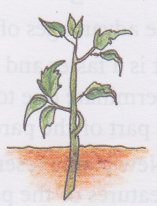
2. Grafting
This is a very common method used in ornamental and fruit plants to develop new varieties, called hybrid varieties. It involves the following steps:
- A bud, or a cutting that has several buds called the scion, of one plant is placed over the cut stem with roots of another plant called the stock.
- The scion and the stock are then firmly tied together.
- The stock supplies water and minerals to the scion. In due course, new cells develop in the area where they are joined and a new variety of plant develops. This is common in plants such as rose, mango, guava, and many other fruit plants.
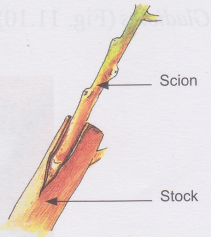
Grafting
3. Layering
This is a method most commonly used in grapes, jasmine, and Bougainvillea.
- In this process, a young branch is lowered down and bent towards the ground and covered by moist soil forming a layer.
- After some time, roots arise from the branch and grow downwards.
- The branch can then be cut off from the parent plant and allowed to grow into a new plant.
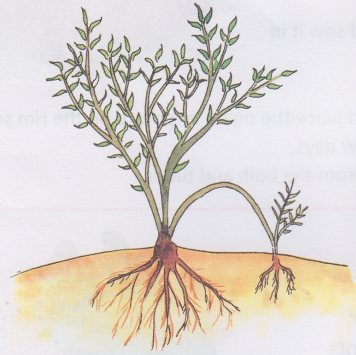
Layering
Advantages of Vegetative Reproduction
The advantages of vegetative reproduction are listed below:
- It is a faster and more certain method of reproduction. Sometimes the seed may not germinate due to unfavourable conditions. But in this case, a new plant directly grows from a part of the parent plant.
- New plants resemble the parent plant exactly. Thus, it helps in conserving characteristic features of the parent plant.
- Plants that do not flower or have seeds can reproduce by this method.
Activity
Aim: To study an onion or a potato for vegetative reproduction
Materials needed: An onion or a potato, a glass jar, water, a pot, and soil
Method:
1. Fill an empty pot with soil.
2. Observe the budding points of a potato (eyes) and sow it in the soil.
3. Water the soil regularly.
4. Another method is to fill a glass jar with water and place the onion or potato on the rim such that half of it is in water. Observe over the next few days.
Observation: Roots and shoots can be seen emerging from the bulb and tuber.
